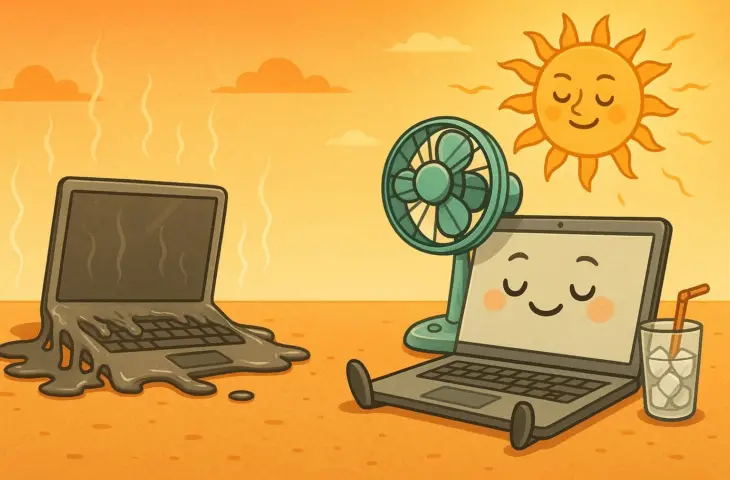During summer, you need to protect not only yourself but also your laptop from overheating. With a few simple steps, you can keep your laptop’s head cool.
If you’re spending the summer behind your laptop instead of on a sunny vacation, pay extra attention to your work environment. Laptops are not sunbathers, and the warmer it gets outside, the higher the risk of your device overheating internally.
Keeping your laptop cool doesn’t require high-tech interventions or expensive equipment. With a few simple steps, you can protect your laptop (and yourself) from the heat. We offer some tips to keep cool during hot workdays.
Overheating: an Invisible Danger
The internals of a laptop heat up during active use. How warm the device gets depends on both external and internal factors. In your device’s technical information, you can find details about the “optimal” temperature range of the external environment for your laptop.
For an “average” laptop, this ranges between 0° C and 35° C, but this can vary from device to device. Rugged laptops, for example, should withstand temperatures up to 60° C.
However, overheating is the result of an excessively high internal temperature. The external temperature influences this, but processor overload is usually the culprit. A “healthy” temperature, again varying from device to device, is roughly between 40° C and 60° C. If it exceeds 80° C, you’re entering the danger zone.
Recognize the Symptoms
Although overheating is an invisible problem, there are indications that the laptop is overheating, such as performance reductions or the battery draining faster. You can sometimes hear a problem, like when your device’s fan is running at full speed while you’re not working hard.
If you see these signs, it’s time to let your laptop cool down before irreversible damage occurs. Your laptop will also try to avoid a fatal heatstroke and will shut itself down when the temperature becomes unbearable.
Overheating can also cause physical damage to your hard drive if the read and write heads start to deform or even melt, resulting in data loss or corruption. An SSD is a bit more heat-resistant but cannot withstand temperatures above 70° C either. Only a backup can help you then.
read also
SSD broke and there is no backup: now what?
Four Tips to Keep your Laptop Cool
Your laptop can overheat just as easily on a cold day if you overload the CPU, but the risk increases on hot days. So take the necessary precautions. These tips will help keep your laptop cool.
Tip 1: Avoid the Sun
The first and simplest tip applies to both people and laptops: stay out of direct sunlight as much as possible. A cool office environment with air conditioning is much more suitable for your laptop than a sunny terrace. If the temptation to work outside is too great, create artificial shade.
You don’t need to buy an expensive sunshade for your laptop: even a simple cardboard box can do the trick. An additional advantage of shade is that you’ll be able to read the screen much better. Close your laptop when you step away from it, as the screen attracts heat. Turn off unnecessary settings.
Ideally, spend your working hours in a cooler indoor environment. Does your living room or office turn into a sauna during the summer? A laptop cooler might help, but we always advise against spending money if it’s not necessary.
Tip 2: Give your Laptop Air
The ventilation in your laptop plays a crucial role in keeping the processor stable. Let it do its job properly. Don’t place your laptop on an uneven surface or your lap for long work sessions. A laptop stand can be useful to create extra space for cooling.
Dust can block ventilation, with all the consequences that entails. Clean the ventilation if you notice your laptop becoming significantly slower. If there’s a structural problem with the cooling, it’s time for a repair.
Tip 3: Careful with Charging
The physical reaction that occurs during charging generates heat. This can be deadly for your laptop on an already warm day. Sometimes charging is, of course, unavoidable, but don’t leave your device on the charger longer than necessary and certainly don’t place it in the sun.
Also, keep an eye on the battery condition. A battery becomes less efficient over the years, causing it to hold the charge less well and produce more heat. Degradation is inevitable, but with smart use, you can keep the battery fit for as long as possible.
read also
Keep your Laptop Cool During Hot Summer Days
Tip 4: Measure the Temperature
To be sure, you can regularly check your PC’s temperature. This can be especially useful when the first signs of overheating start to appear. Strangely enough, Windows doesn’t offer a built-in option for this. You can check the temperature by going into the BIOS settings, but this doesn’t give an accurate picture because the PC isn’t running at full capacity then.
You can take a look at CPU usage. You can closely monitor this via Task Manager. In the Processes menu, you can see how many applications are active and running in the background at any given moment (often more than you think) and how much of the processor and memory is needed to keep them running.
If you prefer something more visual, the Performance menu shows how CPU usage evolves. Constant high CPU usage is a recipe for overheating.

Additionally, there are many applications available for Windows that act as a “thermometer” for your laptop, such as Core Temp, HWMonitor, and Speccy. These measure the temperature of the CPU and/or other frequently used components. Chip manufacturers AMD and Intel also have their own applications to monitor the processor.
